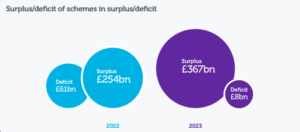In recent years, institutional investors had to adopt the philosophy of the White Queen in Alice in Wonderland and believe six impossible things before breakfast.
If someone had predicted in 2020 that the post global-financial crisis interest-rate cuts would have been unwound over the space of only a year, you would have thought them mad and said: “Impossible!” And yet that is exactly what happened.
Bank of England official rate

Source: Bank of England
Such a rapid interest rate rises have negative implications for mortgage owners and governments.
But for the UK’s defined benefit pension schemes it was good news − as longer dated interest rates have also risen with 10-year gilt yields currently around 4% compared with less than 0.2% in January 2020.
I’ve written in depth in this post about the link between liability valuation and longer dated gilt yields and why ultra-low interest rates were so punitive for closed DB pension schemes. Rising interest rates have done wonders for pension schemes’ funding positions, as the chart below illustrates.
UK pension schemes in surplus/deficit

Source: Purple Book 2023
While any pension scheme will welcome such a healthy improvement in funding levels, for closed private sector company pension scheme these improvements must be seen as a godsend by finance directors.
For years the pension schemes have been the enfant terrible of the balance sheet, funding levels tumbling as interest rates plunged necessitating emergency influxes of cash until it could be stabilised with LDI.
And now what looked like a decade long journey to transfer the whole ghastly enterprise to an insurance via buy out has suddenly truncated to only a few years. Buy out volumes in 2023 are estimated to be around £50bn and WTW recently forecast them to hit £60bn in 2024.
With such high demand from pension schemes, new insurance market entrants have start to enter the buy-out market so we can expect to see buy-out volumes to grow further.
But while amelioration of defined benefit schemes funding levels has been good news for finance directors and insurance companies, it’s much less good news for asset managers.
Fewer closed DB pension schemes now need growth assets to improve their funding positions, cutting off a source of potential asset flows.
In addition, many illiquid assets are off-putting to insurance companies – and often make up too much of a DB scheme’s portfolio because of the LDI crisis – many of the products targeted at this market by managers are no longer a good match.
In the next blog post we will discuss the longer term ramifications for asset managers of insurance companies hoovering up DB assets and as well as the implications for those schemes which either opt for self sufficiency or will take longer to get to buy out.



Comments are closed.